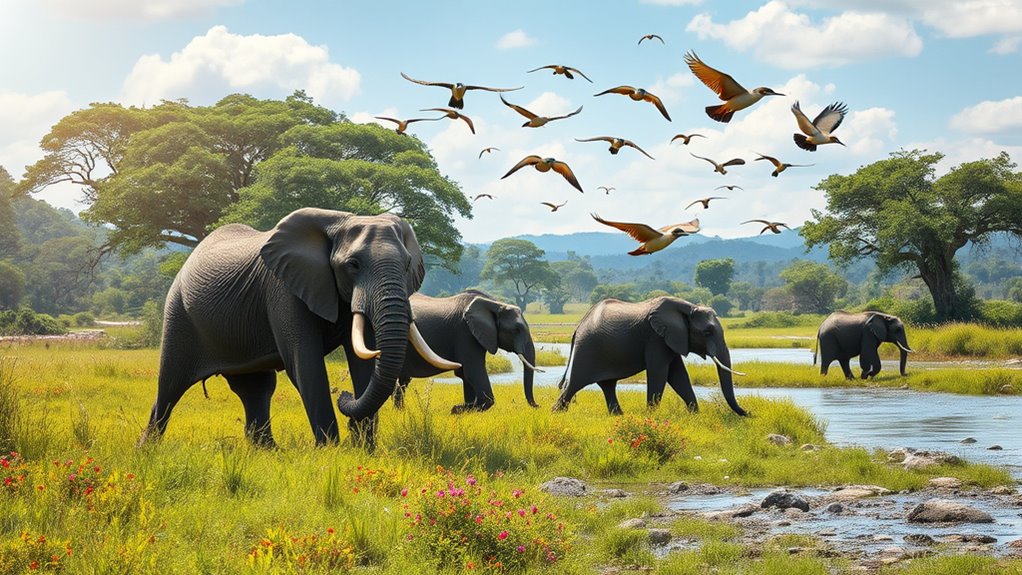In 2025, urban conservation efforts have blossomed, transforming cities into thriving habitats for wildlife and people. City parks, green roofs, and waterways now serve as essential refuges, thanks to community participation and forward-thinking policies. These initiatives have improved biodiversity, air quality, and residents’ well-being. Collaboration among government, conservationists, and residents has shown that wildlife can flourish amid urban life. To discover inspiring stories behind these successes, continue exploring how cities are becoming shared ecosystems.
Key Takeaways
- Urban green space projects have significantly increased biodiversity and supported thriving wildlife populations in cities by 2025.
- Community-led initiatives, such as native plantings and habitat restorations, have played a vital role in urban conservation success.
- Local policies prioritizing wildlife corridors and green infrastructure have enhanced urban ecosystems’ resilience.
- Collaboration among governments, conservationists, and residents has resulted in thriving shared urban habitats.
- Recognition of urban ecosystems’ importance has driven ongoing efforts, ensuring sustainable coexistence of wildlife and city residents.

Despite ongoing challenges, 2025 has marked a remarkable year for wildlife conservation. One of the most significant achievements has been the successful integration of urban habitats into conservation strategies. Cities and towns, once viewed solely as human spaces, are now recognized as essential ecosystems capable of supporting diverse wildlife. You’ve seen how urban parks, green roofs, and restored waterways have become key refuges for birds, insects, and small mammals. These efforts are not just about creating pockets of green but about transforming entire urban landscapes into thriving habitats that benefit both humans and wildlife. Your participation in community engagement initiatives has played a pivotal role in this transformation. When residents come together to plant native species, clean up local parks, or advocate for wildlife-friendly policies, they foster a sense of shared responsibility. This collective effort makes conservation efforts more sustainable and impactful because it’s rooted in local knowledge and passion. Community engagement also helps bridge the gap between city dwellers and the natural world, making conservation a shared goal rather than an external obligation. Through volunteer programs and educational campaigns, you’ve helped raise awareness about the importance of maintaining healthy urban habitats, which in turn encourages more people to get involved. As these initiatives grow, they create a ripple effect—more green spaces are established, pollinator corridors are connected, and urban wildlife populations flourish. You’ve likely noticed how city councils and local organizations have prioritized wildlife corridors and native planting projects, making urban areas more hospitable. This approach not only supports biodiversity but also improves residents’ quality of life by providing cleaner air, reduced noise pollution, and calming natural settings amidst busy streets. Your efforts in community engagement have helped turn this vision into reality, fostering a sense of stewardship among city residents. The collaboration between conservationists, local governments, and communities has proven that even in densely populated areas, wildlife can thrive if given the right opportunities and support. This year’s successes demonstrate that urban habitats are no longer just human spaces but shared ecosystems that require active care and participation. Additionally, the recognition of urban ecosystems as crucial components of biodiversity conservation has further bolstered these initiatives. By continuing to champion community involvement, you’re helping to sustain these urban conservation victories well into the future. Your dedication ensures that cities become not only centers of human activity but also essential habitats where wildlife and people coexist harmoniously. The progress made in 2025 underscores the power of collective action—showing that everyone has a role in shaping vibrant, resilient urban ecosystems.
Frequently Asked Questions
What Specific Methods Contributed Most to These Conservation Successes?
You’ll see that habitat restoration and anti-poaching technology played key roles in conservation success. Restoring natural habitats helps species thrive and rebuilds ecosystems. Meanwhile, anti-poaching tech like drones and thermal cameras deters illegal activities and allows quick response. These methods work together, creating safer environments for wildlife and boosting overall conservation efforts. By focusing on these strategies, you’ve contributed to meaningful, lasting positive changes for endangered species.
How Are Local Communities Involved in Wildlife Protection Efforts?
Coincidentally, you find that involving local communities is key to wildlife protection. You actively engage them through community participation programs, where their traditional knowledge becomes invaluable. By fostering collaboration and respecting local customs, you empower communities to protect their natural resources, ensuring sustainable conservation efforts. This approach not only benefits wildlife but also strengthens local livelihoods, creating a harmonious relationship between humans and nature.
What Challenges Remain Despite These Successes?
Despite these successes, you still face challenges like climate change and illegal poaching. Climate change alters habitats, making it harder for wildlife to survive, while illegal poaching threatens species with extinction. You need to stay vigilant and adapt your efforts to address these issues. Continued community involvement and stricter enforcement are vital to overcoming these obstacles and ensuring long-term conservation success.
Are There Plans to Replicate These Successes Elsewhere?
Yes, plans are underway to replicate these successes elsewhere. You’ll see eco-tourism benefits, like increased local income and conservation awareness, driving expansion. Enhanced legal framework improvements guarantee sustainable practices and stronger protections for wildlife. By sharing successful strategies and fostering partnerships, conservation efforts can grow beyond current regions. Your support and involvement can help scale these initiatives, creating a broader positive impact on biodiversity and community livelihoods worldwide.
How Is Funding Sustained for Ongoing Conservation Projects?
In 2025, you should know that funding stays steady through diverse funding models and partnership strategies. You might think it’s all about government grants, but private donors, corporate sponsorships, and eco-tourism revenue play big roles too. By continuously diversifying sources and building strong collaborations, conservation projects remain resilient, ensuring ongoing support for wildlife initiatives. This approach keeps conservation efforts alive and thriving, even as the landscape evolves.
Conclusion
Just as the phoenix rises from its ashes, these successes remind you that hope and effort can revive what once seemed lost. Your support and dedication breathe new life into endangered species, proving that change is possible. Remember, every small act echoes like ripples in a pond, shaping a future where wildlife thrives. Keep believing in the power of collective action—because, like nature’s resilience, your impact can turn the tide toward a brighter tomorrow.









